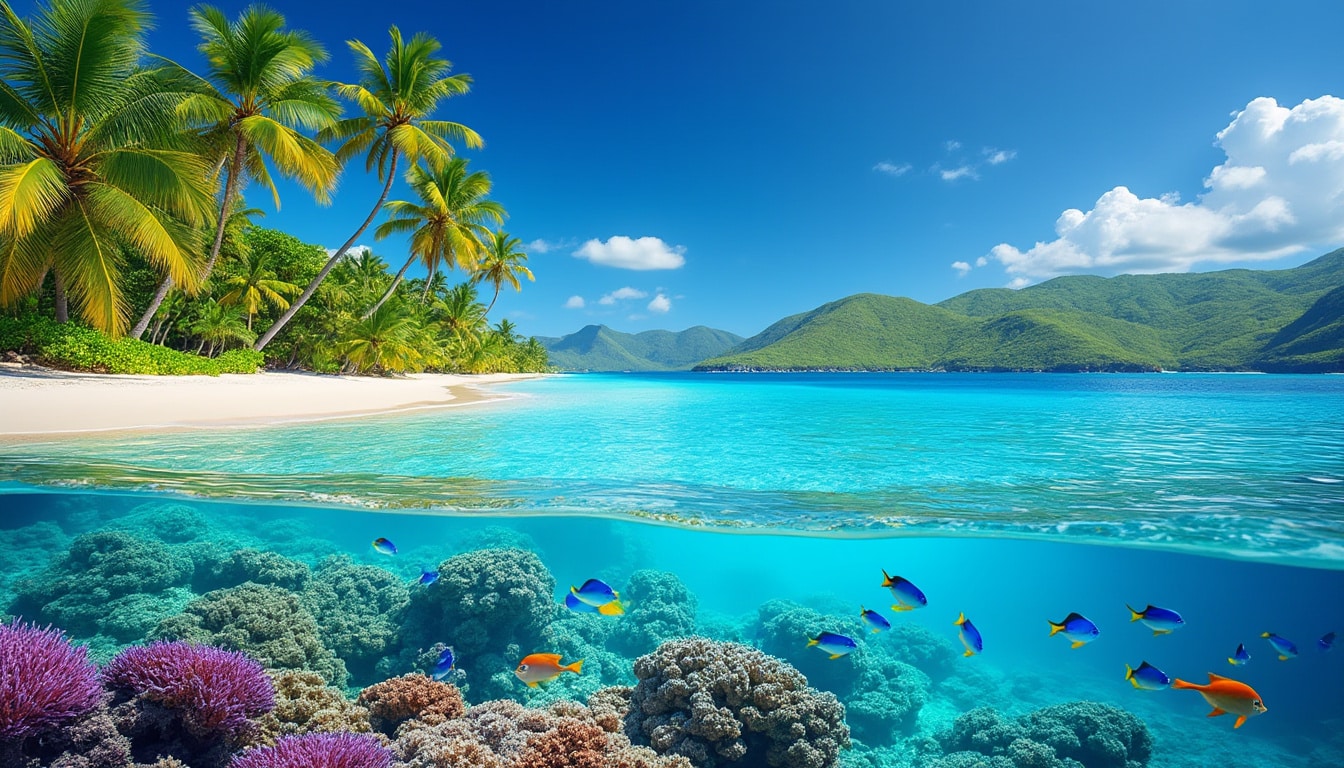Punta Cana, a gem on the eastern extremity of the Dominican Republic, is renowned for its stunning geographical features that attract tourists from all over the world. Nestled between the Atlantic Ocean and the Caribbean Sea, this picturesque region offers a unique blend of natural beauty, cultural richness, and impressive biodiversity. Whether it’s the vast stretch of white sandy beaches, the vibrant marine life, or the lush tropical foliage, Punta Cana presents itself as a true paradise in the Caribbean. This charming location is more than just a traveler’s haven; it’s a study in contrasts where the untouched and the developed coexist harmoniously. To truly appreciate what Punta Cana has to offer, one must delve into its geography and understand how these features shape experiences unlike any other.
Punta Cana’s Unique Coastal Geography
Punta Cana’s sprawling coastline is one of its most defining geographical features, making it an irresistible destination for beach lovers and adventurers alike. This region boasts an impressive array of beaches, each with its distinct characteristics, spanning approximately 70 miles. The beaches in Punta Cana are part of the province of La Altagracia, where the azure waves of the Atlantic Ocean meet the calmer, turquoise waters of the Caribbean Sea, offering diverse aquatic experiences. Macao Beach, known for its rugged beauty and strong waves, is a favorite among surfers, while Bávaro Beach is celebrated for its gentle, warm waters ideal for swimming and snorkeling.
In addition to the beaches, the coastline is dotted with natural marine pools and reefs, providing excellent opportunities for diving and snorkeling. The Punta Cana Marine Reserve, established to protect these underwater ecosystems, is home to a myriad of colorful marine life. For those interested in exploring, diving excursions offer a chance to experience this underwater wonder firsthand.
- 🌴 Macao Beach: Renowned for its adventure and surfing opportunities.
- 🏖️ Bávaro Beach: Perfect for family-friendly swimming and snorkeling.
- 🐠 Punta Cana Marine Reserve: A diver’s paradise.
Furthermore, the natural formation of the coast plays a significant role in providing a safe and enjoyable beach environment. The natural sand dunes and palm trees, which line the beaches, not only add to their beauty but also serve to protect the inland from high tides and strong winds.
| Beach | Activities | Special Features |
|---|---|---|
| Macao Beach | Surfing, Horse Riding | Strong waves, Natural beauty |
| Bávaro Beach | Snorkeling, Swimming | Calm waters, Marine life |
| Juanillo Beach | Kiteboarding, Relaxation | Secluded, Expansive sands |
Punta Cana’s unique geographical setup offers both novice and seasoned travelers an array of activities and breathtaking scenery that remains unmatched. This coastal bliss, with its dynamic interplay of oceanic and terrestrial elements, creates an environment ripe for exploration.

The Role of the Ocean in Shaping Punta Cana’s Identity
The dual presence of the Atlantic Ocean and the Caribbean Sea shapes Punta Cana’s geographical identity and dictates the lifestyle and economic activities of the region. The Atlantic Ocean, with its robust and lively waves, caters to adventure seekers looking for excitement through activities such as surfing and deep-sea fishing. Contrastingly, the Caribbean Sea offers a serene and tranquil environment suitable for leisure activities like sailing and swimming.
One cannot overlook the importance of these bodies of water in connecting Punta Cana to the greater Caribbean and beyond. The Punta Cana International Airport serves as a gateway to the region, making it one of the busiest airports in the Caribbean. This facilitates not only the influx of tourists but also the exchange of goods and cultural interactions with other Caribbean nations.
Inland Landscapes and Biodiversity
Beyond its iconic beaches, Punta Cana’s inland landscapes are equally captivating, featuring a tapestry of tropical flora and fauna. The region’s rich biodiversity is a testament to its varied ecosystems, including mangroves, tropical rainforests, and dry forests.
The Indigenous Eyes Ecological Park and Reserve is a prime example of Punta Cana’s commitment to preserving its natural heritage. This privately owned and protected area covers an impressive 1,500 acres and is home to diverse wildlife, from exotic birds to elusive reptiles. Visitors can explore lush trails, uncovering freshwater lagoons and learning about the importance of these ecosystems in maintaining the balance of the region’s natural environment.
- 🌿 Indigenous Eyes Ecological Park: A conservation area with trails and lagoons.
- 🌺 Exotic Flora: Rich in tropical plants and orchids.
- 🦜 Fauna Diversity: Home to numerous bird species and wildlife.
The mangroves and lagoons in the region also play a crucial role in protecting the coastline from erosion and provide breeding grounds for fish and other marine species. These natural features are essential for ecological sustainability and offer educational insights into Punta Cana’s biodiversity.
| Landform | Flora | Fauna |
|---|---|---|
| Mangroves | Salt-tolerant plants | Crustaceans, Fish |
| Tropical Rainforest | Orchids, Palms | Birds, Reptiles |
| Dry Forests | Succulents, Acacias | Insects, Small mammals |
This combination of diverse landscapes and rich biodiversity forms a cornerstone of Punta Cana’s allure, enticing nature lovers and ecotourists to explore its natural wonders.
The Significance of Conservation Efforts
Conservation efforts in Punta Cana are pivotal in ensuring the sustainability of its geographical features. Organizations such as the Puntacana Ecological Foundation work tirelessly to implement conservation projects that protect the natural environment. From coral reef restoration initiatives to educational programs about sustainable tourism, these efforts aim to preserve the natural beauty and biodiversity of the area for future generations.
Such conservation strategies not only safeguard the environment but also promote eco-tourism, providing an alternative way to appreciate Punta Cana’s natural landscapes while minimizing human impact.
- 🌍 Reef Restoration: Initiatives to restore damaged coral reefs.
- 📚 Educational Programs: Raising awareness about eco-friendly practices.
- 🐢 Wildlife Protection: Efforts to protect endangered species.
The Climate and Weather Patterns of Punta Cana
Punta Cana’s climate is classified as a tropical wet and dry climate, which is characterized by distinct seasonal variations that influence the region’s appeal as a year-round tourist destination. This climate ensures warm temperatures and plenty of sunshine, attracting sun-seekers even during the wetter months.
The region experiences a hot and humid season from May to October, where temperatures can soar to 95°F. This period is marked by higher humidity and occasional tropical storms, yet it remains a popular time for visitors looking to enjoy the lush, green landscape at its peak. The cooler season, from November to March, offers milder temperatures averaging around 79°F, ideal for outdoor activities and excursions.
Understanding the climate is essential for planning a trip to Punta Cana. Travelers often ensure their itineraries align with the weather patterns suited to their preferred activities. For instance, those interested in water-based activities like snorkeling and scuba diving may prefer the cooler, drier months, while sun-lovers and photographers might enjoy the vibrant landscapes of the rainy season.
| Month | Average Temperature (°F) | Rainfall (inches) | Humidity (%) |
|---|---|---|---|
| January | 79 | 3.33 | 82.8 |
| June | 88.2 | 3.69 | 82.2 |
| September | 89.4 | 5.33 | 82.5 |
| December | 84.9 | 3.59 | 83.2 |
These factors, combined with the geographical diversity of Punta Cana, provide invaluable insights into how the area’s climate enhances its status as a leading tourist hotspot.
Planning Travel According to Weather and Climate
It is essential for travelers to understand how Punta Cana’s weather may influence their travel plans so they can make informed decisions for a perfect vacation. Here are some considerations:
- 👨👩👦 Family trips: Ideal during the cooler months for outdoor and water activities.
- 📸 Photography: The rainy season enhances the lush scenery, perfect for capturing vibrant photos.
- 🏄♂️ Surfing: High waves in the hot months cater to thrill seekers.
The Impact of Geography on Tourism Development
Punta Cana’s geography is not only its primary allure but also a driving force behind its thriving tourism industry. This region redefines the concept of a tourist destination by integrating luxury with its natural environment, creating an extraordinary vacation experience. The balance between coastal developments like Punta Cana Resort & Club and naturally preserved areas sets a precedent for sustainable tourism practices globally.
Over the years, resorts such as Tortuga Bay and Majestic Elegance Punta Cana have capitalized on this unique setting. They offer world-class amenities with designs that complement, rather than compete with, Punta Cana’s natural beauty. Such resorts allow visitors to indulge in luxury while remaining connected to the transformative powers of nature.
- 🏨 Tortuga Bay: Blends luxury with environmental consciousness.
- 🎲 Hard Rock Hotel & Casino Punta Cana: Offers entertainment against a tropical backdrop.
- 🌟 Iberostar Gran Bavaro: Integrates environmentally-friendly practices.
| Resort | Unique Feature | Location |
|---|---|---|
| Punta Cana Resort & Club | Eco-friendly luxury | Near Punta Cana International Airport |
| Majestic Elegance Punta Cana | Innovative architecture | Arena Gorda Beach |
| Riu Palace Punta Cana | Vibrant nightlife | Bávaro Beach |
This harmonious balance between nature and development continues to be a point of attraction for global tourists and a model for other tourist destinations. Punta Cana’s geography provides both the backdrop for its tourism and the resources that sustain it, making it a quintessential Caribbean escape.
The Future of Punta Cana as a Tourist Destination
As we look toward the future, Punta Cana’s ongoing commitment to preserving its natural landscapes while enhancing its tourist infrastructure must continue. The area’s growth as a global tourist destination is a testament to its enduring appeal and the potential of sustainable tourism practices. Efforts in conserving biodiversity and promoting eco-friendly developments can ensure that Punta Cana remains a leader in global tourism, offering unparalleled experiences for generations to come.
Frequently Asked Questions (FAQs)
- Where is Punta Cana located? Punta Cana is situated on the easternmost tip of the Dominican Republic, in the province of La Altagracia.
- What is the climate in Punta Cana like? Punta Cana has a tropical wet and dry climate, with a hot and humid season from May to October and a cooler period from November to March.
- How has geography influenced Punta Cana’s tourism? The diverse geography of beaches, marine reserves, and inland forests has shaped Punta Cana into a prime tourist destination offering a blend of luxurious and nature-centric experiences.
- What are some of the popular activities in Punta Cana? Popular activities include snorkeling, surfing, eco-tours, and enjoying the world-class amenities offered by resorts.
- Is Punta Cana suitable for family vacations? Yes, with its family-friendly resorts and plethora of activities suitable for all age groups, Punta Cana is an excellent choice for family vacations.
By understanding the intricate geographical features of Punta Cana, both current and prospective travelers can better appreciate its allure and plan visits that align with their interests and expectations.
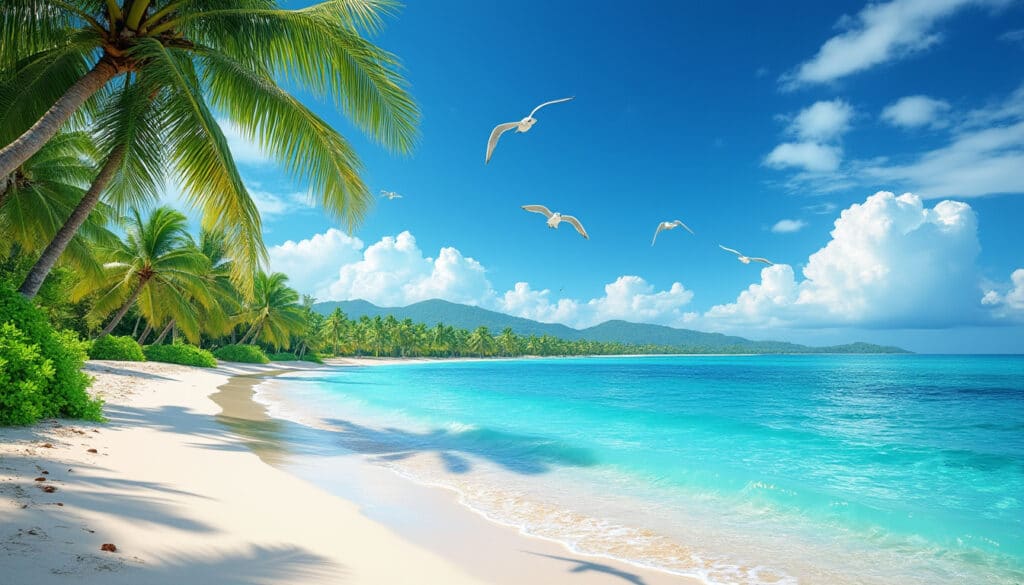
Nature and Geography of Punta Cana
In the realm of dazzling turquoise waters and sun-drenched beaches, Punta Cana stands as a beacon for travelers seeking both relaxation and adventure. Renowned for its stunning natural beauty and strategic location at the merge point of the Atlantic Ocean…
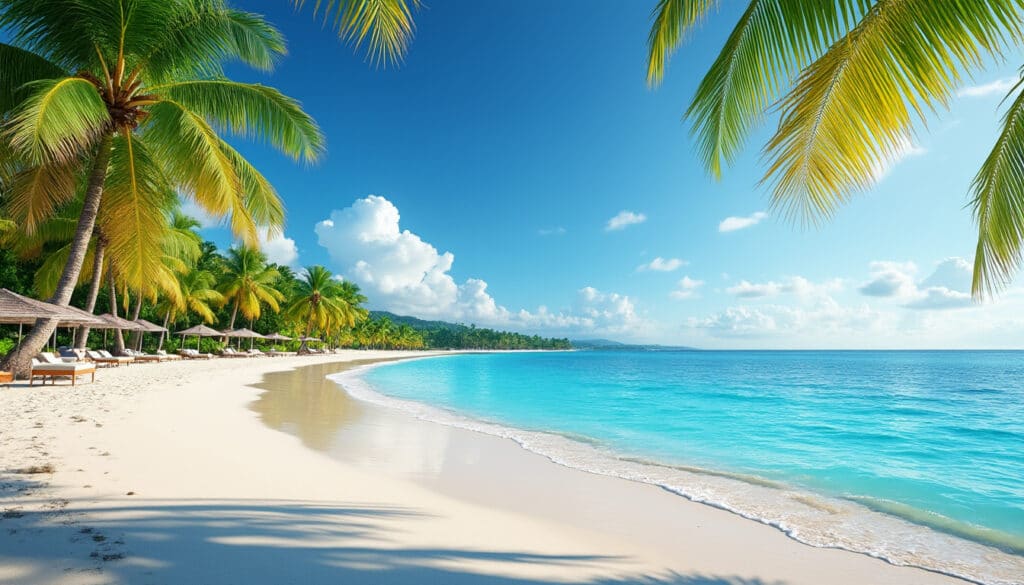
Location and coordinates of Punta Cana
Nestled in the heart of the Caribbean, Punta Cana stands as a beacon for travel enthusiasts in search of sun-soaked beaches and vibrant local culture. With its strategic geographical location, it offers a unique perspective of the Dominican Republic. This…
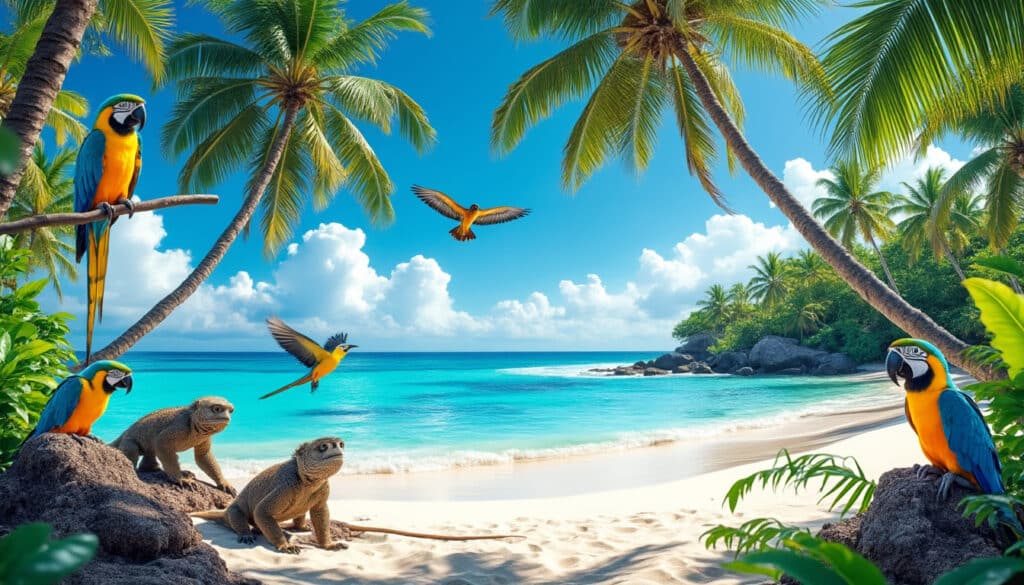
Nature and wildlife in Punta Cana
Known for its stunning beaches and luxury resorts, Punta Cana also offers a rich tapestry of nature and wildlife that beckons to be explored. This Caribbean paradise is not only a haven for beach lovers but also a vibrant ecosystem…
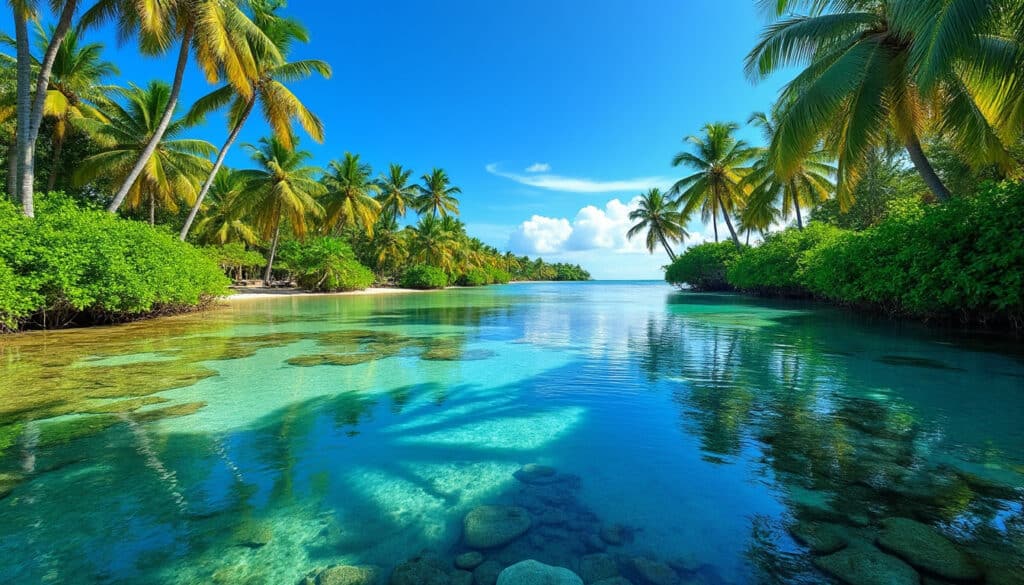
Rivers and water near Punta Cana
Punta Cana, known for its pristine beaches, offers more than just sun and sand. Nestled in the Dominican Republic, this vibrant destination serves as a gateway to some of the Caribbean’s most breathtaking natural wonders, including its serene rivers and…

